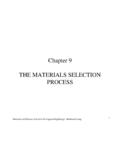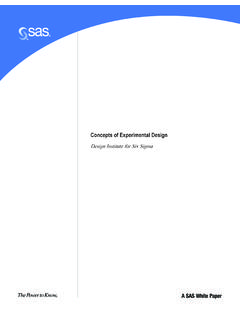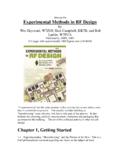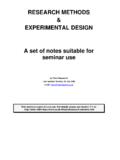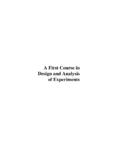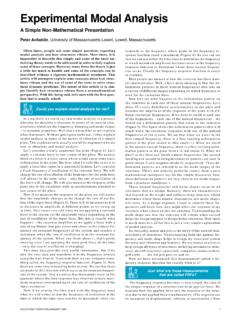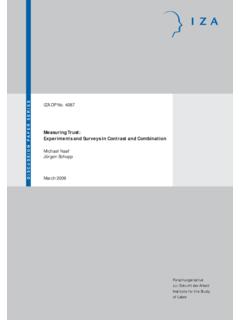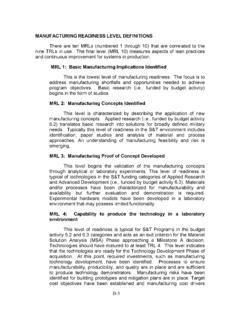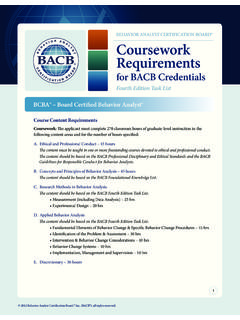Transcription of Chapter 1 PRODUCT DESIGN AND DEVELOPMENT IN THE …
1 Materials and Process Selection for Engineering DESIGN : Mahmoud Farag1 Chapter 1 product design AND DEVELOPMENT IN THE INDUSTRIAL ENTERPRIZEM aterials and Process Selection for Engineering DESIGN : Mahmoud Farag2 Chapter 1 Goals and ObjectivesThe overall goal is to introduce the spectrum of activities that are normally involved in the different PRODUCT DEVELOPMENT phases. The main objectives are to: Review the main activities of performing a feasibility study and selecting an optimum concept. Discuss the main stages of designing and manufacturing a PRODUCT . Discuss the main activities involved in testing and refining a new PRODUCT and then launching and selling it. Analyze the environmental issues that are involved in making a PRODUCT and in retiring it. Explain the concepts of life cycle costing and the PRODUCT life and Process Selection for Engineering DESIGN : Mahmoud Farag3 Stages of PRODUCT developmentA PRODUCT usually starts as a concept which, if feasible, develops into a DESIGN , then a finished PRODUCT .
2 The following seven phases can be identified in a variety of PRODUCT DESIGN and DEVELOPMENT of needs, feasibility study and concept selection, DESIGN , detail DESIGN and selection of materials and processes, and refinement, the PRODUCT the PRODUCT , the PRODUCT , for its retirement. Feasibility studyElements of feasibility study generation, screening and optimum solutionMaterials and Process Selection for Engineering DESIGN : Mahmoud Farag4 Market research range of features and the technical advantages and disadvantages of existing products, the mechanism of their operation, and the materials and processes used in making them. and anticipated market growth rate and expected market share by value and number of companies entering and leaving the market over the past few years, and reasons for those reasons for any modifications which have been carried out recently and the effect of new technology on the or license coverage and what improvements can be introduced over existing products.
3 Materials and Process Selection for Engineering DESIGN : Mahmoud Farag5 Market research II6. Profile of prospective customers (income, age, sex, etc.) and their needs in the area covered by the PRODUCT under Ranking of customer needs in order of their PRODUCT price that will secure the intended volume of How long will it take the competition to produce a competitive PRODUCT ?10. What is the optimum packaging, distribution, and marketing method?Materials and Process Selection for Engineering DESIGN : Mahmoud Farag6 PRODUCT specificationsProduct specifications give precise and measurable description of the expected PRODUCT performance based on the qualitative descriptions of the customer needs. For example,a specification of the total weight of the PRODUCT must be less than 5 kg can be based on the customer need of a light weight PRODUCT and the observation that the lightest competing PRODUCT is 5 kg.
4 Similarly, a specification of average time to unpack and assemble the PRODUCT is less than 22 min. can be based on a customer need of the PRODUCT is easy to assemble and the observation that the competing PRODUCT needs 24 minutes to unpack and and Process Selection for Engineering DESIGN : Mahmoud Farag7 Concept generation and screeningProduct specifications are then used to develop different PRODUCT concepts that satisfy customer needs. Some of the concepts may be generated by the DEVELOPMENT team as novel solutions but others may be based on existing solutions or patents. The different concepts are then compared in order to select the most promising option. The Pugh method is useful as an initial concept screening tool. Materials and Process Selection for Engineering DESIGN : Mahmoud Farag8 The Pugh methods of concept selectionMaterials and Process Selection for Engineering DESIGN : Mahmoud Farag9 Table ( ) Concept Screening Matrix Selection criteria Reference Concept Concept A Concept B Concept C Concept D Criterion 1 Criterion 2 Criterion 3 Criterion 4 Criterion 5 0 0 0 0 0 - + + 0 0 + + + 0 - + 0 + + - 0 0 - - + Total (+) Total (-) Total (0) 0 0 5 2 1 2 3 1 1 3 1 1 1 2 2 Net Score 0 1 2 2 -1 Decision No Consider Consider Consider No Economic analysisThe economic analysis section of the feasibility study normally provides an economic model that estimates.
5 The DEVELOPMENT costs, the initial investment that will be needed, the manufacturing costs, and the income that will result for each of the selected concepts. The economic analysis also estimates sources and cost of financing based on the rate of interest and schedule of payment. Materials and Process Selection for Engineering DESIGN : Mahmoud Farag10 Selecting an optimum solutionFactors involved in selecting an optimum solution: customer needs, physical characteristics of size and weight, expected life and reliability under service conditions, energy needs, maintenance requirements and operating costs, availability and cost of materials and manufacturing processes, environmental impact, quantity of production, expected delivery and Process Selection for Engineering DESIGN : Mahmoud Farag11 Quantitative methods of selecting an optimum solutionMaterials and Process Selection for Engineering DESIGN .
6 Mahmoud Farag12 Table ( ) Concept Selection PRODUCT specifications/ Selection Criteria Weight Concept A Concept B Concept C Rating Weighted rating Rating Weighted rating Rating Weighted rating Criterion 1 Criterion 2 Criterion 3 Criterion 4 Criterion 5 2 4 4 3 3 4 4 4 3 1 4 3 4 5 2 Total score Rank Second Last First (optimum) (Rating: 5 = excellent, 4 = very good, 3 = good, 2 = fair, 1 = poor) Case study: Developing the Greenobile IMarket ResearchThe questions discussed include: of driving the car, how far is each journey on average and expected distance traveled per year, and expected life of the car, qualities: main preferences for body styling and look, number of doors, number of wheels, etc., of comfort on a bumpy road, of handling and parking, issues including stability on the road especially when turning round sharp corners, cost Materials and Process Selection for Engineering DESIGN : Mahmoud Farag13 Case study: Developing the Greenobile IISpecifications PRODUCT Description: A two-seater, inexpensive, environmentally friendly car Primary use: Driving in the city to get to work or go shopping Main customers: Middle class families who may already own a family car Technical specifications: Mass up to 500 kg, Maximum speed 90 km/hr, Speed maintained on 5% gradient 60 km/hr, Acceleration time from 0 90 km/hr average 20 sec Cost Up to $6,000, Safety requirements: Same as a normal sedan car Engine emission.
7 Environmental Protection Agency (EPA) test limits or less Main features:Seating for two passengers, Small boot/trunk accessible from the back Main business goals: Production starts in three years from approval of final concept, Units produced in the first year 20,000 to increase by 10% each subsequent year Materials and Process Selection for Engineering DESIGN : Mahmoud Farag14 Case study: Developing the Greenobile IIIC oncept generation: Concept A: is a sedan with a hard roof, 4 wheels, two seats side-by-side, internal combustion engine, expected life 5 years, expected weight 500 kg, acceleration from 0 90 km/hr is 15 sec, higher level of comfort, expected cost $6,000 Concept B: is a sedan with a hard roof, 3 wheels (one in front and two in the back), two seats side-by-side, rechargeable battery operated engine, expected life 4 years, expected weight 450 kg, acceleration from 0 90 km/hr is 25 sec, medium level of comfort, expected cost $5,000 Concept C: is a sedan with a movable roof, 3 wheels (one in front and two in the back), two seats one behind the other, rechargeable battery operated engine, expected life 4 years, expected weight 400 kg, acceleration from 0 90 km/hr is 20 sec, lower level of comfort, expected cost $4,000 Materials and Process Selection for Engineering DESIGN : Mahmoud Farag15 Case study: Developing the Greenobile IVMaterials and Process Selection for Engineering DESIGN .
8 Mahmoud Farag16 Table Concept selection for Greenobile Selection Criteria Weight Concept A Concept B Concept C Rating Weighted rating Rating Weighted rating Rating Weighted rating 1. Life 2. Aesthetic qualities 3. Level of comfort 4. Ease of handling and parking 5. Safety 6. cost 5 5 5 4 5 3 4 4 4 5 4 4 4 3 3 3 4 5 Total score Rank First Second Third (Rating: 5 = excellent, 4 = very good, 3 = good, 2 = fair, 1 = poor) System-level designMaterials and Process Selection for Engineering DESIGN : Mahmoud Farag17 Launching and selling the productLaunching the PRODUCT : Project planning and scheduling Manufacturing Quality control Packaging MarketingSelling the PRODUCT : Cost of PRODUCT engineering Actual manufacturing cost Sales expense and administrative cost Selling priceMaterials and Process Selection for Engineering DESIGN : Mahmoud Farag18 Case study: Planning for installation of an injection molding machine IMaterials and Process Selection for Engineering DESIGN .
9 Mahmoud Farag19 Table Installing and preparing for operation an injection molding machine Major task Activity Description Immediate predecessor Time (h) I a Excavate foundations - 5 b Pour concrete in foundation a 2 c Unpack parts - 3 II d Place machine body on foundations b, c 2 e Level machine body d 1 f Assemble rest of the machine parts c, e 3 g Connect electrical wiring f 1 h Connect cooling water and drainage f 2 III i Install injection molding die g, h 3 j Calibrate temperature controller i 2 k Place plastic pellets in hopper f 1 l Adjust plastic metering device k 1 m Perform experimental runs j, l 2 Case study: Planning for installation of an injection molding machine IIMaterials and Process Selection for Engineering DESIGN : Mahmoud Farag20 Manufacturing the productMaterials and Process Selection for Engineering DESIGN : Mahmoud Farag21 Selling the PRODUCT IMaterials and Process Selection for Engineering DESIGN : Mahmoud Farag22 Selling the PRODUCT IIMaterials and Process Selection for Engineering DESIGN : Mahmoud Farag23 Recycling of materialsMaterials and Process Selection for Engineering DESIGN : Mahmoud Farag24 Table Energy used for production of some engineering materials Metal Primary metal Secondary metal GJ/ton % GJ/ton % of primary metal Mg 370 100 10 Al 350 100 15 Ni 150 100 15 10 Cu 120 100 20 17 Zn 70 100 20 29 Pb 30 100 10 33 Steel 35 100 15 43 Figures based on: Metals Handbook, Desk Edition, ASM, Metals Park, Ohio, 1985, p Materials and Process Selection for Engineering DESIGN .
10 Mahmoud Farag25 Materials and Process Selection for Engineering DESIGN : Mahmoud Farag26 The PRODUCT life cycleMaterials and Process Selection for Engineering DESIGN : Mahmoud Farag27 Materials and Process Selection for Engineering DESIGN : Mahmoud Farag28 Chapter 1 Summary , PRODUCT DEVELOPMENT is performed by an interdisciplinary team with representatives from different segments of an industrial enterprise including engineering DESIGN , materials and manufacturing, finance, legal, sales, and marketing. This is because in addition to satisfying the technical requirements, a successful PRODUCT should also be aesthetically pleasing, safe to use, economically competitive, and compliant with legal and environmental activities involved in PRODUCT DEVELOPMENT include: concept DEVELOPMENT and feasibility study, system-level DESIGN , detail DESIGN and selection of materials and processes, testing and refinement, launching the PRODUCT , and selling the PRODUCT .
